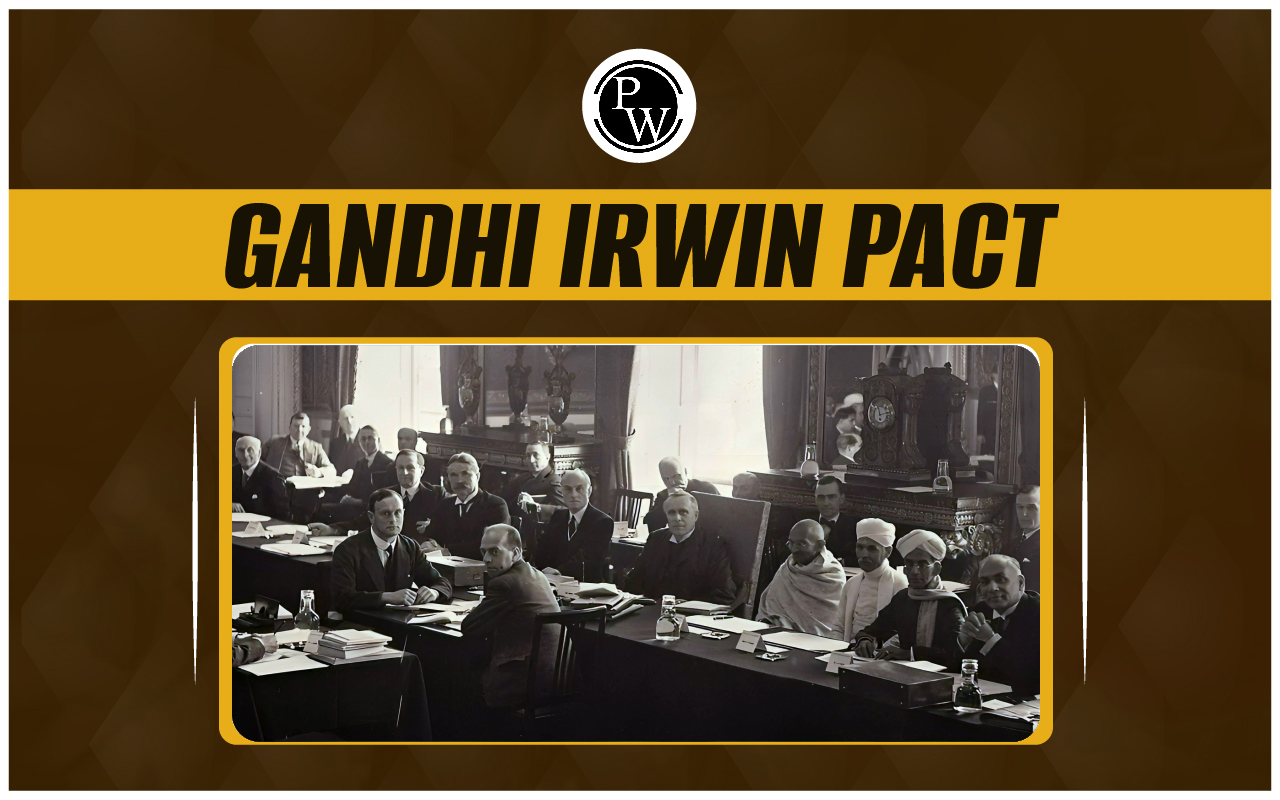

Gandhi Irwin Pact
The Gandhi-Irwin Pact was a significant political agreement signed on March 5, 1931, between Mahatma Gandhi, the leader of the Indian National Congress, and Lord Irwin, the then Viceroy of India. This pact marked a crucial point in the Indian struggle for independence from British rule. Below is an elaboration of the Gandhi-Irwin Pact, its background, terms, and its impact on the Indian independence movement.Gandhi Irwin Pact Background
The Non-Cooperation Movement: The early 1920s saw the rise of the Non-Cooperation Movement led by Mahatma Gandhi, aiming for Swaraj (self-rule) through non-violent means. This movement galvanized millions of Indians, leading to widespread boycotts of British goods, institutions, and services. However, the movement was suspended in 1922 following the Chauri Chaura incident, where violent clashes resulted in the death of 22 policemen.
The Civil Disobedience Movement: In 1930, Gandhi launched the Civil Disobedience Movement, another mass protest against British rule. It began with the historic Dandi March, where Gandhi and his followers marched 240 miles to produce salt from the sea, defying British salt laws. The movement rapidly gained momentum, leading to mass arrests, including that of Gandhi himself. The situation in India became increasingly tense, prompting the British government to seek a resolution.Gandhi Irwin Pact Need for Negotiation
Political Stalemate: By early 1931, the Indian subcontinent was in a state of turmoil due to the Civil Disobedience Movement. The British administration was struggling to maintain order, and the prisons were filled with political prisoners. On the other hand, the Indian National Congress was determined to continue its struggle for complete independence. The stalemate necessitated a dialogue between the two parties.
The Round Table Conferences: The British government organized a series of Round Table Conferences in London to discuss constitutional reforms in India. The first conference, held in 1930, failed to produce significant results as the Congress boycotted it. The British government realized that any meaningful discussion on India's future must include the Congress, necessitating a compromise.
Terms of Gandhi-Irwin Pact
British Concessions:
- Release of Political Prisoners: The British government agreed to release all political prisoners who had not been convicted of violence.
- Return of Confiscated Property: Properties confiscated during the Civil Disobedience Movement were to be returned to their owners.
- Right to Make Salt: Indians were granted the right to produce, collect, and sell salt, which was a symbolic victory for Gandhi's campaign.
- Relaxation of Repressive Measures: The government promised to withdraw repressive measures such as the ban on the Congress party and its activities.
- Suspension of Civil Disobedience Movement: Gandhi agreed to suspend the Civil Disobedience Movement and participate in the Second Round Table Conference.
- Participation in the Conference: The Congress agreed to participate in the Second Round Table Conference, thereby giving it legitimacy.
Impact of the Gandhi-Irwin Pact
Immediate Reactions- Indian National Congress: The Congress welcomed the pact, viewing it as a step towards achieving independence. The release of political prisoners and the right to make salt were seen as significant victories.
- British Government: The British saw the pact as a way to restore order and bring the Congress to the negotiating table.
Gandhi-Irwin Pact Long Term Consequences
Strengthening of the Independence Movement: The Gandhi-Irwin Pact and the subsequent release of political prisoners rejuvenated the Indian independence movement. It demonstrated the effectiveness of non-violent resistance and strengthened the resolve of Indians to continue their struggle. Shift in British Policy: The pact also signaled a shift in British policy towards India. The British recognized the necessity of negotiating with the Indian leadership, particularly the Congress, to maintain control over India. This paved the way for further constitutional reforms, although full independence was still a decade and a half away. Gandhi's Leadership: The pact solidified Gandhi's position as the undisputed leader of the Indian independence movement. His commitment to non-violence and his ability to negotiate with the British earned him widespread respect and support among Indians and international observers.Gandhi-Irwin Pact Criticisms and Controversies
Radical Elements within the Congress Not all factions within the Congress were satisfied with the Gandhi-Irwin Pact. Some radical members felt that the concessions obtained were insufficient and that the suspension of the Civil Disobedience Movement was a strategic error. British Conservative Reaction Some conservative elements within the British establishment criticized Lord Irwin for conceding too much to the Indian nationalists. They feared that the pact would encourage further demands for independence. To succeed in upcoming exams, candidates should consider exploring PW SSC Books We provide high-quality content at an affordable price, including sample papers, mock tests, guidance sessions, and more to ensure aspirants secure their selection. Also, enroll today on SSC Online Coaching to turn your dreams into reality.Gandhi-Irwin Pact FAQs
Q1: What was the Gandhi-Irwin Pact?
Q2: What were the main terms of the Gandhi-Irwin Pact?
Q3: Why was the Gandhi-Irwin Pact significant?
Q4: What were the outcomes of the Gandhi-Irwin Pact?












